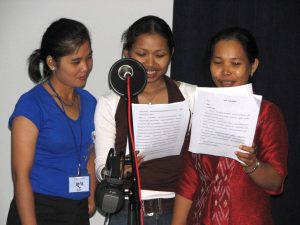Tip of the week 2017-06-12: Storytelling in radio

Recording a radio drama in Cambodia.
I recently heard about a culture in Africa that tells stories in four-line poems. Another ethnic group tells stories in songs. What ways are stories told where you’re from?
I’ve frequently used short stories to introduce or illustrate a point in my educational programs. Stories are great for that purpose: they can get the listener emotionally involved in the storyline, and listening passionately to hear how the story turns out—will the hero win the battle? Or will evil conquer?
Stories can also be good as teaching tools in themselves. I’ve heard serial dramas—set in a small farming town—that have been used to teach basic health lessons. Great idea!
Whether you use multiple voices to produce a dramatized story, or a single voice to narrate a story, here are a few tips for telling good stories:
Have a clear structure. Another word for this is ‘plot,’ or storyline. It’s the main direction your story goes, from beginning to end. The plot should include these major components:
- Opening—make it a strong one, that captures the listener’s attention. This might be a dramatic scene of a problem the audience can relate to. Think of this as the ‘hook’ (think fish-hook, with something tasty to attract the fish)
- Middle—this is the main part of the story, with all the complexity of the plot as it develops. Your story will be better if you can include:
- A sub-plot, a minor story within the story, to keep things interesting. This will only work well if your story is a reasonable length. It’s difficult to work a sub-plot into very short radio stories!
- A surprise—something to make people afraid or excited
- Conflict—either within the main character’s own thoughts, or possibly a conflict between people. Make it realistic, so listeners can identify with the problem
- Humour—add in a bit of humour now and then, to break up the tension of the conflict. It helps listeners to appreciate the story as a story, but also gives them a bit of relief from the constant tension of the conflict.
- End—this is where the peak, or climax, of the conflict comes to its highest point of tension near the end of the story. After it is resolved, the level of tension is reduced and the story can conclude.
A short story I wrote for an educational programme had all these features:
- Opening: An eerie howl and a squeaking gate as Mario entered the graveyard
- Middle:
- Plot: Mario had to walk through the graveyard at night to get the doctor
- Sub-plot: Mario’s mother was sick and would die without help
- Surprise: unexpected noise that made Mario’s fear of ghosts create more tension
- Conflict: Mario was sure the ghosts would get him if he entered the graveyard; certain that his mother would die if he didn’t
- Humour: the unexpected noise was a cute kitten hiding behind a gravestone
- End: Mario is out of the graveyard and knocks on the doctor’s front door. Door opens and the doctor greets him…end of story.
So…this is the path a story can take. But what about other things, like characterisation, use of dialogue and sound effects?
Aah, well: that’s a story for another time! J
Happy broadcasting,
Janice Reid